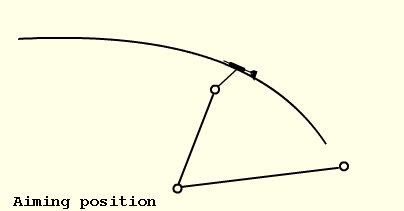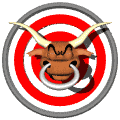DARTS HOME

Credits to Tom Neijman from Sitepeople for making this fine animation of throwing mechanics!
The above image already shows the 'aiming' position when throwing darts. In the following animation you can watch how the 'levers' and 'hinges' work in a decent darts throw, keeping the dart exactly along the curve.
DOs and DON'Ts of a dart throw
Before proceeding you can (and you should!) take yourself some time to watch the above animation carefully. First watch each element on its own, then continue to see the whole arrangement, and how each part of it interacts with the others to keep the dart on course.
On joints and levers
The shoulder: This is the only point in the whole process that doesn't change its postion. So you must not move (that's a DON'T, yes!) your body when throwing. The only throwing action comes from your arm.
The elbow: It stays in position when moving the dart backward, and on some point in the acceleration phase starts to go up. This is a very intersting thing, because you may have heard the advice that the elbow should also stay fixed during the throw. This is actually wrong. Again, watch the animation: A fixed elbow would force you to release the dart earlier. This is like the difference in accuracy between a pistol and a rifle. The rifle's longer barrel increases accuracy. The same does the longer guidance of the dart, and as we have to keep the dart on course, too, the elbow must be raised in the later phase of throwing. Also note that the hand still follows the way of the dart after we released it. This makes the release easier, because we don't have to find an absolutely exact release point any more. It doesn't matter much if we drag it out a bit, the dart will still stay in a nice flying position anyway.
The wrist: Wrist action is an often discussed subject. In the animation there is not much of it, so you see it is not absolutely necessary. But most pro players use wrist snap because of one reason: It helps in acceleration. Doesn't the way the 3 'levers' move remind you of a whip? If you do wrist snap the tip of our 'whip' (which is, actually, uhm, the dart) will go faster, and therefore you will be able to move the other parts of the lever system slower, thus put less force in your throw, and this will improve accuracy. But there is one danger in wrist snap: It's one more thing that must be controlled, and so one more source for errors. While most experts and pros use it, I wouldn't recommend it to beginners that don't have the natural gift to control it.
The phases of the throw:
Aiming: Put your eyes, the dart and the target you want to hit in one line. Focus the target, not the dart or that pretty girl/boy just entering the bar. Use aiming points on the target if you like, or aim in a different way, but: Aim!. Most darters do aiming naturally, but surpisingly some beginners don't do from the start. It's a must DO, so do it.
Backward move: Do this, but don't do it too fast. Many beginners fear the necessary loss of aiming during the backward move, but controlling this is only a matter of practice. There are only few successful players out who omit the backward movement, so it's another DO for 99 percent of us. How far you move back is a personal thing, but it's good to move back quite a bit. If you find it comfortable, you can and should move back as far as possible. You can avoid slamming into your eyes or nose by pulling back under your chin or beside your cheek (the one in your FACE, of course!), that depends on your personal technique. A typical error here is not to pull back enough because control of this is difficult, but you will thus sacrifice a lot of acceleration space and accuracy. Better practice more than going the easy way!
Acceleration: Not that crucial as you might think. Do it naturally, and don't do it too fast or with too much force. Do it smoothely in one move and all the way to the follow-through. Remember the elbow coming up. IF you do wrist-snap, then your hand goes forward in this phase until full extension of the whole arm in follow-through.
Release: As wrote above, with the right throwing this comes naturally and is no big problem. If you have troubles with the release point, then most probably you do a technical error, don't raise your elbow or don't do follow-through. This is the critical point for your wrist-snap. The hand must be in the correct angle to the forearm here. If it has travelled further, your dart points down at the release point, and this - well, refer to the 'The Dart' section at the end of this document.
Follow-through: A very important thing. Remember the shotgun-rifle comparison. Best way to follow-through is to end up with your hand aiming at the chosen target. A typical error is to let your arm 'fall down' after the release. Just keep your arm in the straight and slight upward position for a moment, just like in the above animation, and you will get the feeling for follow-through quite fast.
Wobble: Almost every beginner's dart wobbles considerably. Pro's and expert's darts hardly ever wobble. Wobbling can have the following reasons:

SPECIAL OUTS
It is important to look at the area from 61-70 with only two darts in your hand. If you find yourself in this situation this is what you do:
70- T20, D5
69- T19, D6
68- T18, D7
67- T17, D8
66- T16, D9
65- T15, D10
64- T14, D11
63- T13, D12
62- T12, D13
61- T11, D14
On all of these outs, even if you miss the triple and catch a single, you will guarantee your self a third dart at the double bull to win,or single bull in soft tip games when single bull has been selected (kinda cool, huh). Notice the pattern, the triple is always the same as the last number of the out. There is also a pattern for the doubles, as you go down the list the triples decrease by 1 and the doubles increase by 1. Look closely at the relationship between the triple and double for 63 and 62. This relationship will help you to remember these triples and doubles.
S.P.R.E.
S.P.R.E. Formulas
The S.P.R.E. formulas are based on specific feats thrown during a match. The feats are listed
below along with their point values.
301
6 Dart Out 20.0
7 Dart Out 9.0
8 Dart Out 8.0
9 Dart Out 7.0
10, 11, 12 dart out 3.5
Low Ton (Scoring 100-150 pts with 3 darts) 2.0
High Ton (Scoring 151-180 pts with 3 darts) 4.0
Hat Trick (3 scoring bulls) 5.0
Win (throwing the winning dart) .5
Calculating 301 S.P.R.E.
Below is an example of how to calculate your 301 S.P.R.E. rating.
Game 1 Game 2 Game 3
Low Ton 2.0 High Ton 4.0 Low Ton 2.0
Low Ton 2.0 High Ton 4.0
11 Dart Out 3.5 7 Dart Out 9.0
Win .5 Lose Win .5
Total 8.0 4.0 15.5
The total for all 3 games is 27.50. Dividing that by 3 (the number of games) gives you a S.P.R.E. rating of 9.17.
501 S.P.R.E.
9 Dart Out 52.0
10 Dart Out 44.0
11 Dart Out 22.0
12 Dart Out 11.0
13, 14, 15 Dart Out 5.5
Low Ton 1.5
High Ton 6.5
Hat Trick 4.0
Win 2.0
Assist (Your partner threw the winning dart) 1.0
Cricket S.P.R.E.
8 Dart Out 17.0
9 Dart Out 17.0
White Horse (Hitting 3 unmarked triples in one throw) 6.5
9 Mark Round (note, all 9 marks must count) 5.5
8 Mark Round 4.5
7 Mark Round 3.5
6 Mark Round 2.5
5 Mark Round 1.5
Cricket Hat (all 3 darts in bullseye) 2.5
Win (throwing the winning dart) 50